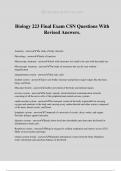©THEBRIGHTSTARS 2024
Biology 223 Final Exam CSN Questions With
Revised Answers.
Anatomy - answer✔✔The study of body structure
Physiology - answer✔✔Study of function
Microscopic Anatomy - answer✔✔deals with structures too small to be seen with the naked eye
Macroscopic Anatomy - answer✔✔The study of structures that can be seen without
magnification
integumentary system - answer✔✔skin, hair, nails
skeletal system - answer✔✔gives our bodies structure and protects major organs like the heart,
lungs, and brain
Muscular System - answer✔✔enables movement of the body and internal organs
nervous system - answer✔✔the body's speedy, electrochemical communication network,
consisting of all the nerve cells of the peripheral and central nervous systems
cardiovascular system - answer✔✔The transport system of the body responsible for carrying
oxygen and nutrients to the body and carrying away carbon dioxide and other wastes; composed
of the heart, blood vessels, and blood.
lymphatic system - answer✔✔Composed of a network of vessels, ducts, nodes, and organs.
Provides defense against infection.
digestive system - answer✔✔Breaks down food into absorbable units that enter the blood for
distribution to body cells.
Respritory system - answer✔✔Bring in oxygen for cellular respiration and remove excess CO2.
Made of nose trachea and lungs
urinary system (renal) - answer✔✔Eliminates nitrogenous wastes from the body. Regulates
water, electrolyte and acid-base balance of the blood.
, ©THEBRIGHTSTARS 2024
endocrine system - answer✔✔Glands secrete hormones that regulate processes such as growth,
reproduction, and nutrient use (metabolism) by body cells.
reproductive system - answer✔✔Reproduce offspring- produce male sex cells (sperm) and
female sex cells (oocytes)
What function do the respiratory system and renal system have in common? -
answer✔✔regulates blood pH
Which is the only organ system that can be removed and will not kill you? -
answer✔✔reproductive system (does not function at birth)
What is a major function of the skin that involves sunlight? - answer✔✔production of vitamin D
Integument is another name for the______ - answer✔✔skin
What is the primary function of the endocrine system? - answer✔✔produce hormones
organ level - answer✔✔2 or more different tissues working together
organ system - answer✔✔2 or more organs working together
total organism - answer✔✔all of the organ systems working together
How is the lymphatic system important in regulation of interstitial fluid? - answer✔✔returns
tissue fluid to the blood
Homeostasis - answer✔✔process by which organisms maintain a relatively stable internal
environment
set point - answer✔✔a value that is defended to maintain homeostasis
autoregulation - answer✔✔causes immediate, localized homeostatic adjustments
intrinsic regulation - answer✔✔automatic response in a cell, tissue, or organ
Extrinsic regulation - answer✔✔Responses controlled by nervous and endocrine systems
feedback loop components - answer✔✔receptor- structure that is sensitive to the stimulus control
center- gets info from receptor, sends command to effector
effector-muscle, glands, adipose tissue. responds and tries to restore
negative feedback loop - answer✔✔Causes a system to change in the opposite direction from
which it is moving
positive feedback loop - answer✔✔a feedback loop in which change in a system is amplified
, ©THEBRIGHTSTARS 2024
Anitomical Position - answer✔✔Erect posture, Head, Eyes and Toes pointing forward, Feet
together, Arms by the side, Palms point forward
bilateral symmetry - answer✔✔arrangement of body parts so there are distinct left and right
halves that mirror each other
Directional Terms - answer✔✔Superior or cranial - toward the head end of the body; upper
(example, the hand is part of the superior extremity).
Inferior or caudal - away from the head; lower (example, the foot is part of the inferior
extremity).
Anterior or ventral - front (example, the kneecap is located on the anterior side of the leg).
Posterior or dorsal - back (example, the shoulder blades are located on the posterior side of the
body).
Medial - toward the midline of the body (example, the middle toe is located at the medial side of
the foot).
Lateral - away from the midline of the body (example, the little toe is located at the lateral side of
the foot).
Proximal - toward or nearest the trunk or the point of origin of a part (example, the proximal end
of the femur joins with the pelvic bone).
Distal - away from or farthest from the trunk or the point or origin of a part (example, the hand is
located at the distal end of the forearm).
Body Regions - answer✔✔head, neck, trunk, upper appendage, lower appendage
abdominopelvic regions - answer✔✔right hypochondriac, epigastric, left hypochondriac, right
lumbar, umbilical, left lumbar, right iliac, hypogastric, left iliac
Planes of the body - answer✔✔sagittal, frontal, transverse, oblique




